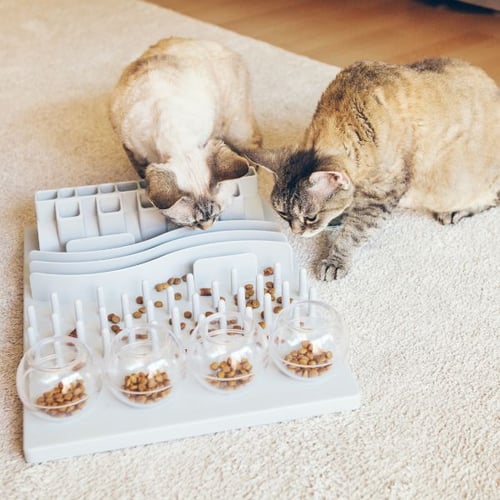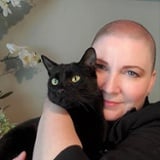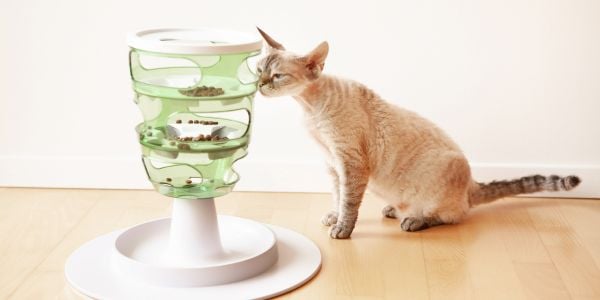 What the heck is a food puzzle, and why does my cat need one?
What the heck is a food puzzle, and why does my cat need one?
Food puzzles are actually fantastic to add to your kitty-care toolkit.
They can help with a variety of behavior issues, make life more exciting for your cat when you’re gone, and help keep their brains active and engaged as they age.
Let’s learn more about food puzzles.
What Is a Food Puzzle and How to Use It
If it takes more effort than sticking their face in a bowl and eating, it’s a food puzzle. We’re really talking about anything that gets your cat using their brain to figure out how to get the food.
You can buy commercial food puzzles. You can make them out of things you have around the home. You can even just drop some kibble in a non-breakable glass or mug turned on its side. Anything can be a food puzzle (as long as it’s safe for your cat).
Food puzzles can be filled with treats or kibble. You'll probably need to start with treats. Let's face it. If it's not worth the effort, your cat isn't going to be interested. But once they get the idea, they're usually pretty happy to work a little for some of their mealtime kibble.
There are even some food puzzles that work with wet food and liquid treats. You'll find some of my favorites below.
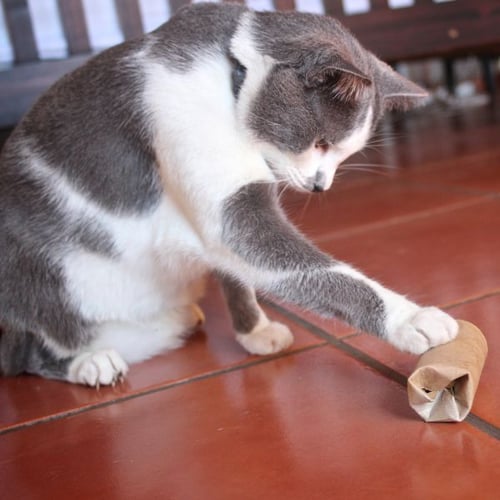
Skip to section:
Why Use Food Puzzles for Your Cat?
There are so many reasons to incorporate food-related brain games into your cat’s daily enrichment.
Burning Mental Energy
We tend to forget that mental work can often be as exhausting as physical work. That goes for cats, too. Especially if you have a super high-energy cat, which is often the case with kittens and young cats, food puzzles can help you wrangle and manage that energy so they don’t find their own more destructive ways to meet their needs.
Helping With Boredom
Cats aren’t designed to sleep all day. They do that in our homes because there’s often nothing else to do. Or they take the opposite route, looking for their own forms of entertainment that we’re not so fond of, like climbing the curtains, opening all the cabinets in the kitchen, or pulling all your pants with drawstrings out of the closet (yes, that one happens to me).
Food puzzles can help with both lazy, bored cats and destructive, bored cats.
Burning Anxious Energy
Many cats have some anxiety. It may be there all the time. Or there may be moments here and there where something triggers a little stress. You don’t know what’s wrong, but you can tell they’re on edge. Grab a food puzzle!
If you’re having an anxious day and you roll around in all that anxiety, you feel worse. If you get up and do something, you generally feel better; the same idea for your cat.
Give them something to focus on when they're anxious to burn off that energy and help them feel better. The less time they spend anxious, the less they’re likely to revert back to anxious behaviors. Even something like overgrooming from stress can be redirected to a food puzzle.
Holding Your Cat's Attention in a Positive Way
There are times when you need your cat to focus on something positive. Maybe you’re working to introduce a new cat to the family or trying to improve the relationship between your cat and dog. Perhaps your cat is anxious around kids or strangers. You guessed it. It’s time for a food puzzle.
Treats are one of the best ways to reward your cat for calm, brave behavior. They’re also great for encouraging your cat to engage. Adding a food puzzle to the mix means they have something positive to reward and encourage their engagement. And it will hold their attention more than simply eating a tossed treat off the floor.
They focus on the food puzzle, so they’re less likely to be bothered by what’s happening around them, like the kids playing loudly or the new kitty jumping up on the couch.
Supplementing Physical Activity
There will be times throughout your cat’s life when they may not have the option to be physically active. Maybe they’ve lost mobility with age. They could be recovering from a medical issue or minor surgery.
This is when you really want to lean into mental enrichment, like food puzzles. It’s easy to find or create them specifically to work with your cat’s physical limitations. The Catit Digger only requires one paw to reach into a cup, so it's a good puzzle for mobility-challenged cats.
Note: If your cat is recovering from surgery, be sure to consult with your veterinarian to be sure that a food puzzle will not interfere with your cat’s activity restrictions.
Fun During Alone Time
If you’re gone long hours at work, setting up a food puzzle or two can be a great way to give your cat something to do while you’re away. Throughout the day, they’ll get that spark of interest and hit the food puzzle for some entertainment. This is also great for your pet sitter to do when you’re traveling and they come by to check on your cat. They can set out food puzzles at the end of each visit.
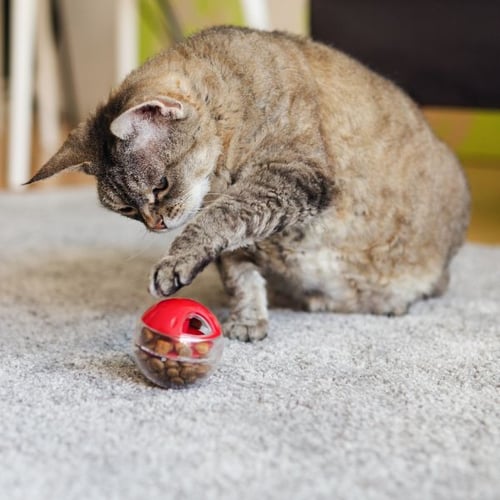
Teaching Your Cat to Use a Food Puzzle
Sometimes, it’s as easy as plopping a food puzzle on the floor with some treats in it and letting your cat go at it. But often, you have to ease cats into this challenging new barrier between them and their treat or their regular food.
It's ideal to start with treats, as you want the "hunting" to be as exciting as possible and worth the extra effort. See below for more ideas on what to put in your cat's food puzzle.
- Start easy. Don’t even buy a food puzzle. Just use things you have around your home. You want to show your cat that food is going to start coming from strange places, and that’s OK. Try a muffin tin or a clean sour cream container. Drop some treats in. Your cat will stick their head in and eat. It’s not hard. But it’s a start.
If they aren’t interested, increase the value of the treat. Go for the all-time favorites. In time, you can decrease the treat value. But make it worth the effort early on.
Note: Do not leave your cat unsupervised when teaching them how to use a food puzzle. Also, do not use any containers that your cat can get their head stuck in. - Gradually increase the challenge. When they’re doing well with step one, make it a little more difficult. Crumple up a paper towel and put that on top of the treat. Now, they have to move something out of the way to get to the goods.
- Shrink their access. Now, try smaller containers. Yogurt cups, then egg crates, then an ice cube tray. As it gets smaller, they can’t just stick their face in and eat the treats. They have to use their paws to fish the treats out.
- Get creative. From here, all kinds of things can be a food puzzle. You can make them or buy them. As your cat gets good at each puzzle, turn up the difficulty to keep challenging and working those brains.
If your cat gets bored with a food puzzle, and they will, don’t toss it. Just put it away for a couple of months while they try out a different puzzle. Then, bring it back out down the road when they’ve forgotten about it.
The Best Cat Interactive Food Puzzles
Here are some of my kitty’s favorite food puzzles and others that I recommend to my clients all the time.
Cat Puzzles By Difficulty Level
Easy Puzzles
If your cat hasn't used interactive food puzzles before, it's a good idea to start with an easy puzzle so they don't get frustrated and give up.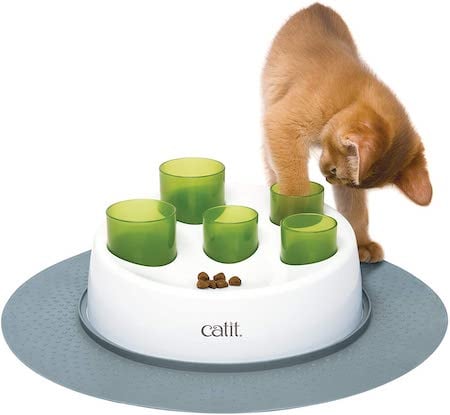
Catit Senses 2.0 Digger (as featured in the photo)
Buggin' Out Puzzle & Play Treat Puzzle
Harder Puzzles for Cats
Cat Amazing Treat Box Interactive Maze
Adjustable Difficulty
You can make these interactive feeders easier to start and more challenging as your cat becomes an expert.
PetSafe SlimCat Mean Dispensing Ball
Doc & Phoebe's Hunting Snacker for Cats
Catit Senses 2.0 Food Tree (this toy is the first one we show at the top of the article – it's great!)
This Is the Uber Puzzle – Good for more than one cat
This puzzle is great if you have two or more cats who are comfortable working on one puzzle together.
Trixie Activity Fun Board (as featured in the photo above)
Puzzles for Wet Food or Treats
There are even a few options for wet food or wet treats, like Churu (a favorite of most cats). These are technically slow feeders but still challenge your cat.
Even though your cat's wet food and liquid treats are likely to have some additives that keep them from going bad quickly, it's still a good idea to limit how long those are left out for your cat. If they haven't eaten all of the wet food or liquid treats after an hour, toss it since bacteria (such as Salmonella or Listeria) could have grown in it, and clean the food puzzle so it's ready for the next time. We recommend against using raw food in puzzles, as bacteria can grow in as little as 20 minutes. See our tip about washing below.
LickiMat Fish-Shaped Cat Slow Feeder
Doc & Phoebe's Wet Food Feeder
Don’t forget to wash your food puzzles regularly. This is especially true if you’re using wet food or treats or any sort of raw treat. Many can go in the dishwasher (usually the top rack). Or follow standard handwashing guidelines — dish soap and hot water.
We found a great chemical-free cleaner, Tersano's iClean® mini. Using only tap water and technology that turns the water into a powerful oxidant through an electrical charge, it kills E. coli, Listeria, and Salmonella by 99.999% in 5 minutes (in as little as 30 seconds on some surfaces). It's quite incredible!
Completely spray the food puzzle or toy, after removing the leftover food, with the "charged" water and let it sit for 5 minutes or more. No rinsing or scrubbing is necessary.
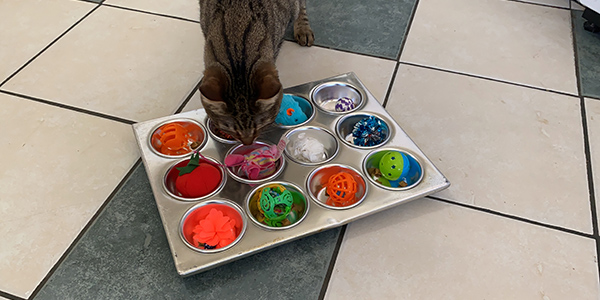
DIY Cat Food Puzzles
Because cats get bored easily, it can be frustrating and costly to constantly buy new food puzzles. Try making some of your own to rotate in with the commercial options. If you have children (or access to free labor from the kids of family and friends), making food puzzles can be a wonderful, creative activity to do together. Here are a few super simple ideas.
- Punch holes in a water bottle and add treats. Your cat can roll it around to get the treats to fall out of the holes. You can make it harder or easier based on the size of the holes.
- Punch holes in a paper bag (never plastic) and use binder clips to attach it to the bottom rung of a chair so it’s like a pinata. Your cat has to bat at the paper bag to get the treats to fall out. Difficulty depends on the size and number of holes.
- Staple one end of a toilet tissue tube and put treats in the other side. Your cat has to reach in and pull the treats out. (If you’re concerned about staples or if your cat likes to chew the cardboard, use a binder clip to hold one end closed.)
- Cut larger holes around the edges of a box and drop treats inside. Your cat has to reach in, as if they were going for a mouse in a mouse hole, to get the treats.
- Forget the physical puzzle. Sometimes, it’s great fun to take a handful of treats or kibble and just toss them in the air. Your cat can use their sense of smell to track down every last piece. You can also hide treats around your home. Start easy. Over time, you can get pretty clever with your hiding spots. Your cat will randomly pick up the scent of the hidden treats throughout the day and get to use their skills to seek them out.
And here are a few Pinterest pages with lots of crafty ideas.
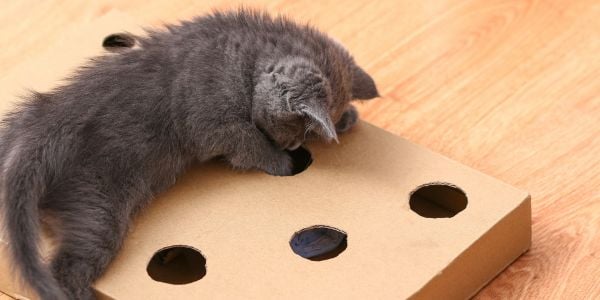
What Should You Put in Your Cat’s Food Puzzle?
Some cats are more than happy to work for their daily kibble in a food puzzle. While I wouldn’t suggest starting out with your cat’s entire meal fed via food puzzle (that could be stressful), you can certainly work up to that point.
If your cat requires a little something special to convince them to do the work, you can try different treats and see what they respond to. Just keep in mind that the size and shape of the treat may make the puzzle harder or easier to work. If you have to shake and shimmy the puzzle to get the treat to fall out, your cat may not have much luck.
If you find your cat's daily calories are adding up due to food puzzles with treats, in addition to their regular meals, you can pull back a bit on their mealtime calories to make up the difference. There are also treats that are high in protein and lower in calories to make treat time a healthy option.
Note: As a guideline, treats should not exceed 10 to 15% of your cat’s daily caloric intake. Use this calculator to help you determine how many calories per day your cat needs to consume to maintain their ideal body weight. Once you know how many calories per day your cat can consume, calculate what percent of that can be treats. It is important to be aware of the calories per serving for the diet you feed your cat as well as the different treats you give.
Treats that Cats Love
Single-ingredient protein treats are a great option. They’re healthier than many other treats and often higher in protein. Since there’s only one ingredient, you know exactly what your cat is getting. And if your cat has special dietary requirements or needs to eat or avoid certain proteins, these treats make it easy. There are many flavors and brands to choose from.
All the treats listed below are 2 or 3 calories per treat. Some are large enough to break into pieces, too.
PureBites Freeze-Dried Chicken Breast Treats
PureBite Freeze-Dried Tuna Treats
PureBite Freeze-Dried Salmon Treats
PureBites Wild Caught Minnow Cat Treats
These two treats are less than 2 calories, but are not all protein.
Halo Holistic Indoor Cat Food – not technically a treat, but could be used as one
Chewy treats, with their meaty texture, are perfect for a post-play session snack because they give your cat that feeling of eating their prey after “hunting” it during play.
Blue Buffalo Soft Chicken & Turkey Treats
Rachael Ray Nutrish Salmon Treats
Crunchy treats can help with dental health and usually work well in food puzzles.
Blue Buffalo Crunchy Chicken Treats
Greenies Oven-Roasted Chicken Flavor Treats
In the wet treat category, nothing beats a Churu! Clean ingredients and an entire tube is only about 6 kcals (calories).
Medical Consideration: If your cat is on a prescription or special diet and your veterinarian does not recommend other food or treats, you still have options. Many prescription cat foods have an accompanying treat made from the same “safe” ingredients, or you can convert the canned food version into treats using a mold and freezing them. These can then be broken up into smaller pieces.
You can also ask your vet if you can try the same diet from a different brand. For example, Royal Canin, Hills Science Diet, and Purina Pro all have a urinary care diet. They’re all going to follow the same general ingredient guidelines based on the health issue they address. But they’ll have different flavors. Feed your cat meals in one brand and use the other brand for treats. But always slowly introduce any new food options.
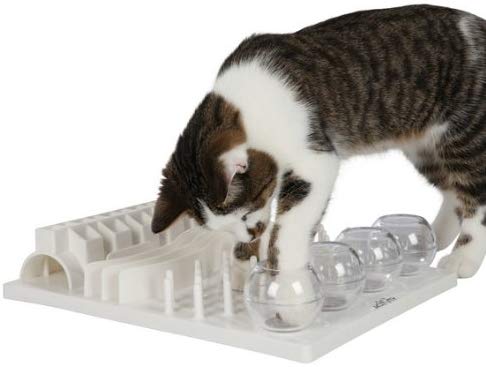
So, you see, there are food puzzle options for every cat in every situation. They’re wonderful mental enrichment and can be used in a variety of helpful ways during socialization and positive reinforcement work. They’re great to give your cat something to do when you’re away from home. And, let’s face it, it’s pretty adorable watching your cat work through the challenge of that puzzle. You’ll be a proud cat parent! Give food puzzles a slot in your daily cat care routine.



